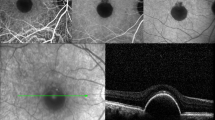Abstract
Purpose
To investigate postoperative thickness changes in the retinal layers in eyes with epiretinal membrane (ERM). Correlations between these changes and visual outcomes were also examined.
Methods
Retrospective review of 25 eyes (24 patients) that had undergone pars plana vitrectomy for ERM and had a postoperative follow-up period ≥6 months. Optical coherence tomography (6 × 6 mm macular thickness map) was used to measure mean thickness of the inner and outer retinal layers 1 week and 1, 3, and 6 months following surgery. Photoreceptor outer segment (PROS) length was evaluated manually, and used to assess the association between best-corrected visual acuity (BCVA) and retinal layer thickness at the fovea.
Results
At 1 week and 1, 3, and 6 months, retinal layer thickness was 388, 377, 362, and 352 μm for the whole layer; 133, 115, 107, and 101 μm for the inner layer; 138, 145, 147, and 148 μm for the outer layer; and 28, 35, 36, and 40 μm for the PROS length, respectively. In comparison to 1-week data, the inner layers were significantly thinner at 1 month and later, as was the thickness of the entire retina. Outer layer thickness and PROS length were also significantly thicker at these time points. Six months following surgery, BCVA was significantly correlated with an elongated PROS length (R = 0.49, P = 0.01).
Conclusion
Retinal outer layer thickness significantly increased following pars plana vitrectomy for ERM. Visual improvement was positively correlated with PROS length recovery.





Similar content being viewed by others
References
Smiddy WE, Maquire AM, Green WR, Michels RG, de la Cruz Z, Enger C, Jaeqer M, Rice TA (1989) Idiopathic epiretinal membranes. Ultrastructural characteristics and clinicopathologic correlation. Ophthamology 96:811–820
Kim J, Rhee KM, Woo SJ, Yu TS, Chung H, Park KH (2010) Long-term temporal changes of macular thickness and visual outcome after vitrectomy for idiopathic epiretinal membrane. Am J Ophthalmol 150:701–709
Bovey EH, Uffer S, Achache F (2004) Surgery for epimacular membrane: impact of retinal internal limiting membrane removal on functional outcome. Retina 24:728–735
Kwok AK, Lai TY, Li WW, Woo DC, Chan NR (2004) Indocyanine green assisted internal limiting membrane removal in epiretinal membrane surgery: a clinical and histological study. Am J Ophthalmol 138:194–199
Kwok AK, Lai TY, Yuen KS (2005) Epiretinal membrane surgery with or without internal limiting membrane peeling. Clin Exp Ophthalmol 33:379–385
Massin P, Allouch C, Haouchine B, Metge F, Paques M, Tangui L, Erginay A, Gaudric A (2000) Optical coherence tomography of idiopathic macular epiretinal membranes before and after surgery. Am J Ophthalmol 130:732–739
Suh MH, Seo JO, Park KH, Yu HG (2009) Associations between macular findings by optical coherence tomography and visual outcomes after epiretinal membrane removal. Am J Ophthalmol 147:473–480
Mitamura Y, Hirano K, Baba T, Yamamoto S (2009) Correlation of visual recovery with presence of photoreceptor inner/outer segment junction in optical coherence images after epiretinal membrane surgery. Br J Ophthalmol 93:171–175
Inoue M, Morita S, Watanabe Y, Kaneko T, Yamane S, Kobayashi S, Arakawa A, Kadonosono K (2011) Preoperative inner segment/outer segment junction in spectral domain optical coherence tomography as a prognostic factor in epiretinal membrane surgery. Retina 31:1366–1372
Wojtkowski M, Srinivasan V, Fujimoto JG, Ko T, Schuman JS, Kowalczyk A, Duker JS (2005) Three-dimensional retinal imaging with high-speed ultrahigh-resolution optical coherence tomography. Ophthalmology 112:1734–1746
Hajnajeeb B, Georgopoulos M, Sayegh R, Geitzenauer W, Schmidt-Erfurth U (2012) The role of the optical coherence tomography in identifying shape and size of idiopathic epiretinal membranes. Br J Ophthalmol 96:867–871
Shiono A, Kogo J, Klose G, Takeda H, Ueno H, Tokuda N, Inoue J, Matsuzawa A, Kayama N, Ueno S, Takagi H (2013) Photoreceptor outer segment length: a prognostic factor for idiopathic epiretinal membrane surgery. Ophthalmology 120:788–794
Tanikawa A, Horiguchi M, Kondo M, Suzuki S, Terasaki H, Miyake Y (1999) Abnormal focal macular electroretinograms in eyes with idiopathic epimacular membrane. Am J Ophthalmol 127:559–564
Niwa T, Terasaki H, Kondo M, Piao CH, Suzuki T, Miyake Y (2003) Function and morphology of macula before and after removal of idiopathic epiretinal membrane. Invest Ophthalmol Vis Sci 44:1652–1656
Ooto S, Hangai M, Takayama K, Sakamoto A, Tsujikawa A, Oshima S, Inoue T, Yoshimura N (2011) High-resolution imaging of the photoreceptor layer in epiretinal membrane using adaptive optics scanning laser ophthalmoscopy. Ophthalmology 118:873–881
Gass JDM (1999) Müller cell cone, an overlooked part of the anatomy of the fovea centralis: hypotheses concerning its role in the pathogenesis of macular hole and foveomacualr retinoschisis. Arch Ophthalmol 117:821–823
Yamada E (1969) Some structural features of the fovea centralis in the human retina. Arch Ophthalmol 82:151–159
Forooghian F, Stetson PF, Meyer SA, Chew EY, Wong WT, Cukras C, Meyerle CB, Ferris FL (2010) Relationship between photoreceptor outer segment length and visual acuity in diabetic macular edema. Retina 30:63–70
Forooghian F, Stetson PF, Gross NE, Meyerle CB (2010) Quantitative assessment of photoreceptor recovery in atypical multiple evanescent white dot syndrome. Ophthalmic Surg Lasers Imaging 41:77–80
Author information
Authors and Affiliations
Corresponding author
Rights and permissions
About this article
Cite this article
Hashimoto, Y., Saito, W., Saito, M. et al. Retinal outer layer thickness increases after vitrectomy for epiretinal membrane, and visual improvement positively correlates with photoreceptor outer segment length. Graefes Arch Clin Exp Ophthalmol 252, 219–226 (2014). https://doi.org/10.1007/s00417-013-2432-2
Received:
Revised:
Accepted:
Published:
Issue Date:
DOI: https://doi.org/10.1007/s00417-013-2432-2




